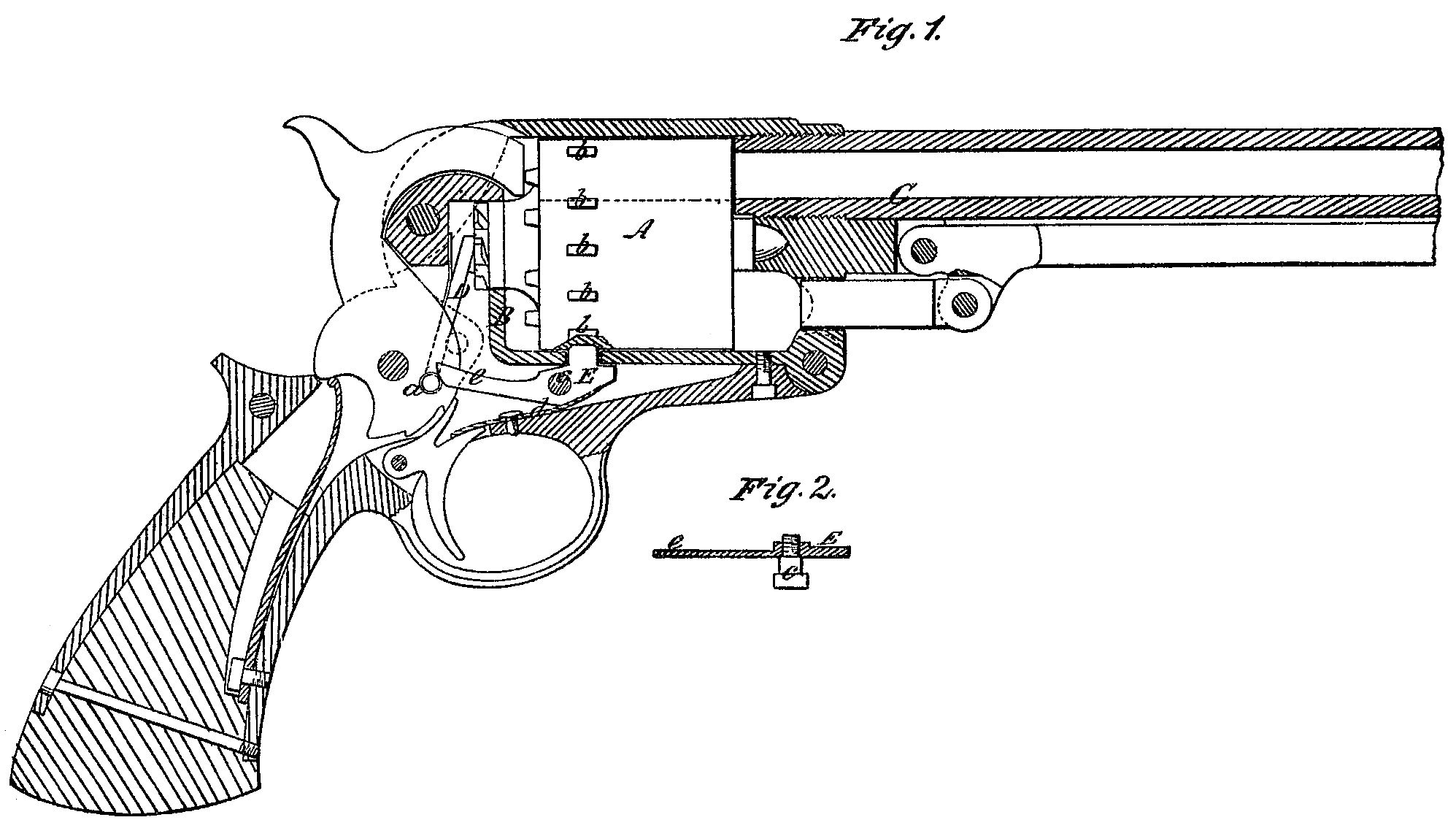US 42435
UNITED STATES PATENT OFFICE.
THOMAS GIBSON, OF YONKERS, NEW YORK, ASSIGNOR TO THE STARR ARMS COMPANY, OF SAME PLACE.
IMPROVEMENT IN LOCKING CYLINDER OF REVOLVING FIRE-ARMS.
Specification forming part of Letters Patent No. 42,435, dated April 19, 1864.
To all whom it may concern:
Be it known that I, Thomas Gibson, of Yonkers, in the county of Westchester and State of New York, have invented a new and useful Improvement in Revolving Fire-Arms; and I do hereby declare that the following is a full, clear, and exact description of the same, reference being had to the accompanying drawings, forming a part of this specification, in which—
Figure 1 represents a longitudinal vertical central section of my invention. Fig. 2 is a detached sectional view of the bolt which serves to lock the chambered cylinder.
Similar letters of reference in both views indicate corresponding parts.
This invention consists in the employment or use of the pivot of the pawl or finger which serves to impart motion to the revolving cylinder in place of the cam to release the bolt or latch from the cylinder in such a manner that the construction of the hammer is simplified and the cam brought in such relation to the bolt that the end of the shank of said bolt is less liable to wear away than it does with hammers of the ordinary construction, and consequently a correct operation of the bolt in regard to the cylinder is secured.
To enable others skilled in the art to make and use my invention, I will proceed to describe it.
A represents the cylinder, which rotates in the frame B, behind the stationary barrel C, in the usual manner. The cylinder is rotated by the action of a pawl or finger, D, which is carried by a pivot, a, passing through and secured in the tumbler of the hammer. When the hammer is cocked or down the cylinder is locked by a bolt or latch, E, the head of which passes through a suitable opening in the under side of the cylinder-frame, and catches into notches l in the circumference of the cylinder, in the usual manner. The bolt E oscillates on a screw, c, within a recess of the cylinder-frame, and said screw is provided with a shoulder, as clearly shown in Fig. 2 of the drawings, so as to prevent the bolt from getting out of position. A spring, d, which bears upon the back of the bolt, has a tendency to hold its head in contact with the circumference or in the notches b of the cylinder, and the shank of such bolt forms a spring-lever, e, the end of which is commonly acted on by a cam inserted in the tumbler of the hammer. Instead of using a separate cam for this purpose, as in revolving fire-arms of the ordinary construction, I form the end of the fulcrum-pin a of the pawl D into a cam, and that portion of the tumbler of the hammer which in hammers of the ordinary construction carries the cam, and which is indicated by red dotted lines in Fig. 1, can be dispensed with. The construction of the hammer is thus considerably simplified, and, furthermore, the position of the cam is much more favorable in relation to the bolt that it is in revolving fire arms of the ordinary construction. When the hammer is down the end of the shank e stands opposite to the cam, and in cocking the hammer the cam rolls over said end of the shank, and, finally, when the calm is brought in such a position that it nearly releases the bolt the end of the shank still bears on the same with a flat surface and not with a mere point, as it does when the cam is inserted into the tumbler of the hammer in the ordinary position. The shank of my bolt, therefore, is not liable to wear off, and the bolt will drop with tile greatest precision into the notches of the cylinder, whether the arm is new or whether it has been used for a long time, whereas in revolving fire-arms of the ordinary construction the points of the shanks are liable to wear off in a short time and the correct action of the bolt is disturbed.
From this description it will be seen by my improvement the construction of the hammer is simplified and a fire-arm is produced of superior durability and precision in the action of its mechanism.
What I claim as new, and desire to secure by Letters Patent, is—
The arrangement and combination of the bolt E with the fulcrum-pin a of the pawl or finger D, in the manner and for the purpose herein shown and described.
THOS. GIBSON.
Witnesses:
James McClatchie,
A. B. Grover.

